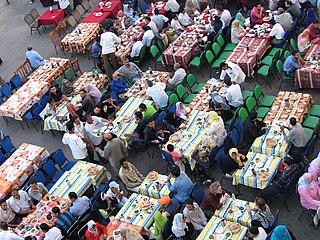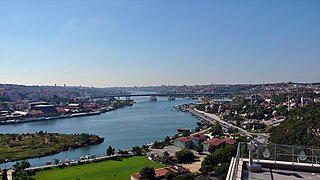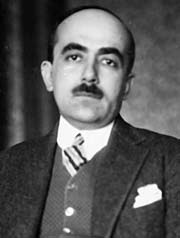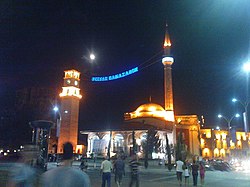
A minaret is a type of tower typically built into or adjacent to mosques. Minarets are generally used to project the Muslim call to prayer (adhan), but they also served as landmarks and symbols of Islam's presence. They can have a variety of forms, from thick, squat towers to soaring, pencil-thin spires.

The Blue Mosque in Istanbul, also known by its official name, the Sultan Ahmed Mosque, is an Ottoman-era historical imperial mosque located in Istanbul, Turkey. It was constructed between 1609 and 1617 during the rule of Ahmed I and remains a functioning mosque today. It also attracts a large number of tourists and is one of the most iconic and popular monuments of Ottoman architecture.

Iftar is the fast-breaking evening meal of Muslims in Ramadan at the time of adhan of the Maghrib prayer.

Eyüpsultan or Eyüp is a municipality and district of Istanbul Province, Turkey. Its area is 228 km2, and its population is 422,913 (2022). The district extends from the Golden Horn all the way to the shore of the Black Sea. Eyüp is also the name of a prominent neighborhood and former village in the district, located at the confluence of the Kâğıthane and Alibey streams at the head of the Golden Horn. The Eyüp neighborhood is a historically important area, especially for Turkish Muslims, due to the presence of the tomb of Abu Ayyub al-Ansari, the prominent Medinan companion (Ansar) and standard-bearer of the Islamic prophet Muhammad.

The Selimiye Mosque is an Ottoman imperial mosque, which is located in the city of Edirne, Turkey. The mosque was commissioned by Sultan Selim II, and was built by the imperial architect Mimar Sinan between 1568 and 1575. It was considered by Sinan to be his masterpiece and is one of the highest achievements of Islamic architecture as a whole and Ottoman architecture in particular.

Yakup Kadri Karaosmanoğlu was a Turkish novelist, journalist, diplomat, and member of parliament.

The large Fatih Mosque is an Ottoman mosque off Fevzi Paşa Caddesi in the Fatih district of Istanbul, Turkey. The original mosque was constructed between 1463 and 1470 on the site of the Church of the Holy Apostles. Seriously damaged in the 1766 earthquake, it was rebuilt in 1771 to a different design. It is named after the Ottoman sultan Mehmed the Conqueror, known in Turkish as Fatih Sultan Mehmed, who conquered Constantinople in 1453.

Ortaköy Mosque or Büyük Mecidiye Camii in Beşiktaş, Istanbul, Turkey, is a mosque situated at the waterside of the Ortaköy pier square, one of the most popular locations on the Bosphorus. It was commissioned by the Ottoman sultan Abdülmecid I and its construction was completed around 1854 or 1856.

The Eyüp Sultan Mosque is in the Eyüp district of Istanbul, outside the city walls and near the Golden Horn. The mosque complex includes a mausoleum marking the spot where Ebu Eyüp el-Ansari, the standard-bearer and companion of the Islamic prophet Muhammad, is said to have been buried. On a much older site, the present building dates from the beginning of the 19th century.

Haji Bayram Veli or Wali (1352–1430) was an Ottoman poet, Sufi saint, and the founder of the Bayrami Order. He also composed a number of hymns.

The Mihrimah Sultan Mosque is a 16th-century Ottoman mosque located near the Byzantine land walls in the Edirnekapı neighborhood of Istanbul, Turkey. It was commissioned by Mihrimah Sultan, the daughter of Suleiman the Magnificent, and designed by the chief imperial architect Mimar Sinan. Sited on the summit of the Sixth Hill near the highest point of the city, the mosque is a prominent city landmark.
Kandil refers to five Islamic holy nights, celebrated in Ottoman and Muslim Balkan communities, related to the life of the Islamic prophet Muhammad, when the minarets are illuminated and special prayers are made. It is a tradition dated back to the Ottoman Sultan Selim II of the 16th century, who with the support of the Shaykh al-Islām "Chief Jurisconsult" of the time, thought it was appropriate to light up the minarets on mosques for these blessed occasions.

The Eyüp Cemetery, aka Eyüp Sultan Cemetery, is a historic burial ground located in the Eyüp district, on the European side of Istanbul, Turkey. It is administered by the General Directorate of Foundations. One of the oldest and largest Muslim cemeteries in Istanbul, it hosts graves of Ottoman sultans and court members, grand viziers, high-ranked religious authorities, civil servants and military commanders as well as intellectuals, scientists, artists and poets.
The Karaosmanoğlu Dynasty is a family that were derebey or ayans, part of the land owning elite in the peripheral provinces, during the Ottoman Empire. After the empire fell, its members have continued to have an impact in Turkey and abroad.
Hırka-i Şerif Mosque is a historic mosque in Istanbul, Turkey. It takes its name from a relic, the mantle of Muhammad, which is preserved in the mosque.

İkdam was a newspaper in the Ottoman Empire and Turkey published between 1894 and 1928. During its lifetime it became the most popular newspaper in Istanbul.

The Yakovalı Hasan Paşa Mosque is an early 17th-century mosque in Pécs, southern Hungary. It was constructed when the region was part of the Turkish Ottoman Empire, together with the main mosque of Pécs, the Mosque of Pasha Qasim. It was named after the local government official who commissioned the mosque, Yakovalı Hasan Paşa, or Hasan Pasha of Yakova. It is thus one of the oldest mosques existing in Hungary today, and is considered to be the most intact mosque to have survived from the Ottoman era. The mosque is still active as a Muslim place of worship, and also houses a small exhibition centre for Turkish handicraft and historical artifacts documenting Hungary's Ottoman past.
Ayşe Adilşah Kadın was a consort of Ottoman Sultan Mustafa III.
Şehzade Mehmed Seyfeddin Efendi was an Ottoman prince, the son of Sultan Abdulaziz and Gevheri Kadın.

Taksim Mosque is a mosque complex in Taksim Square, Istanbul. It was designed by two Turkish architects in the Art Deco style, and can hold up to 3,000 worshippers at the same time. Construction began on February 17, 2017, and lasted for four years. The mosque was inaugurated with a Friday prayer attended by the President, Recep Tayyip Erdoğan, on 28 May 2021.



















